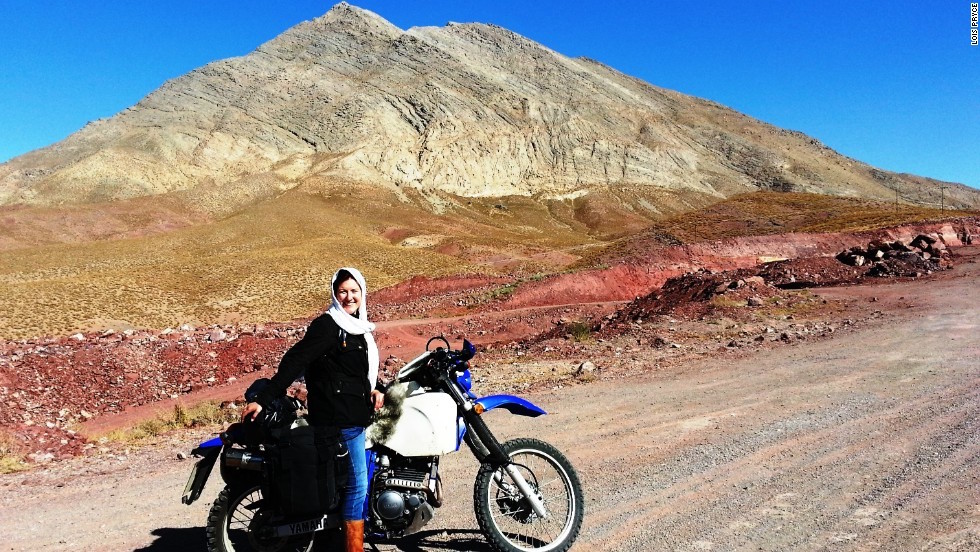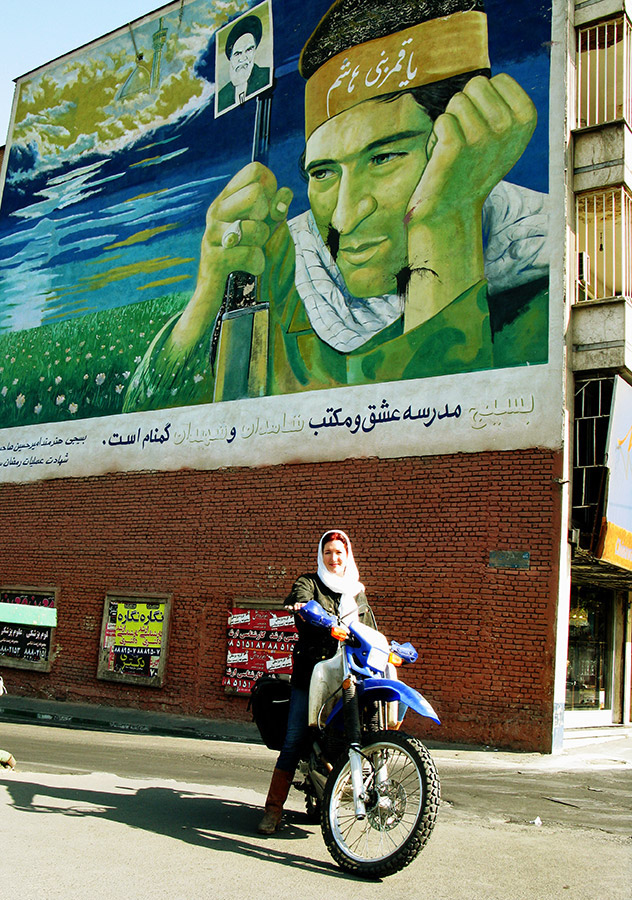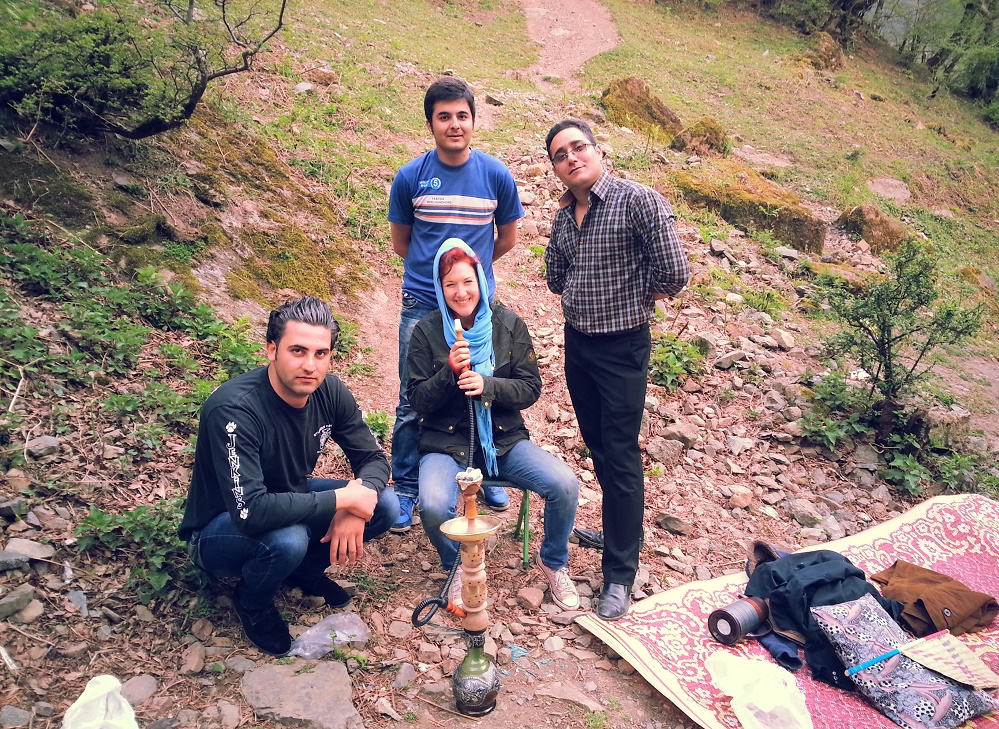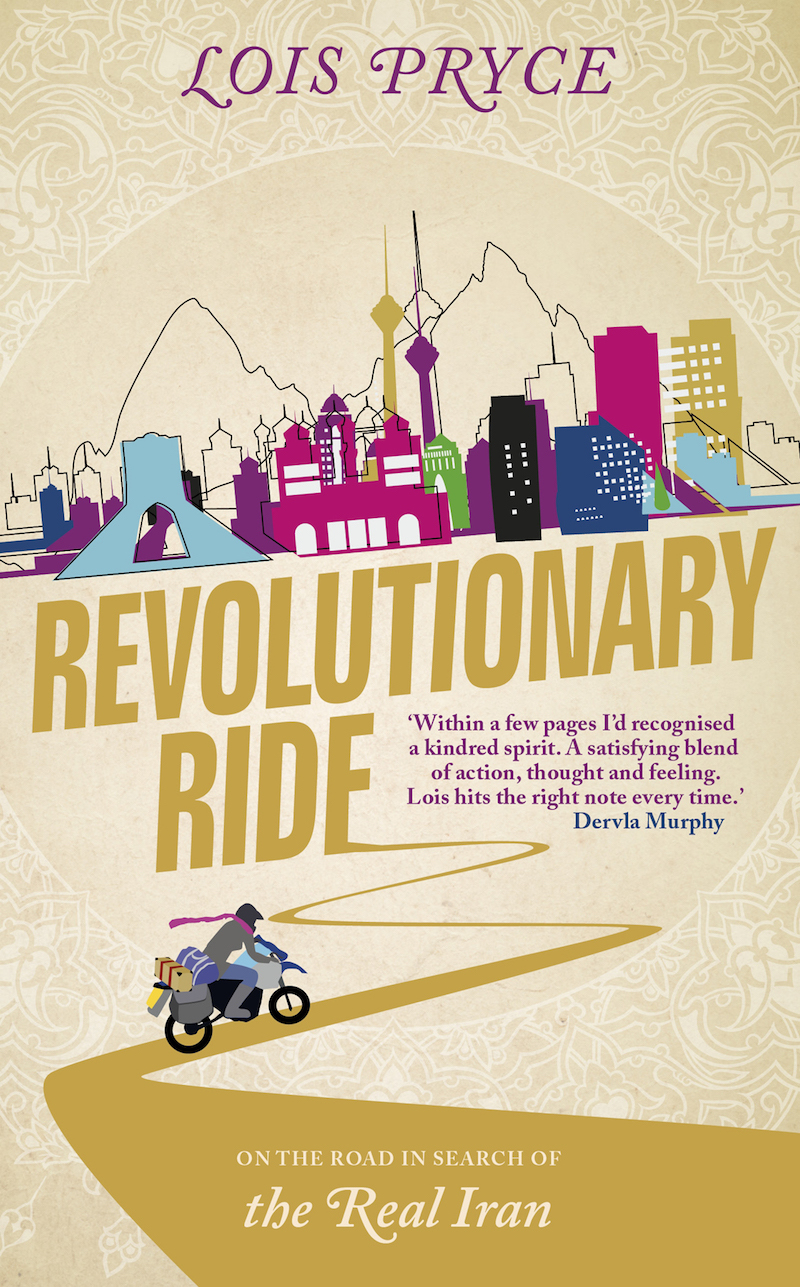Revolutionary Ride: On the Road in Search of the Real Iran
A reader writes
I feel bad about this, as it may be the only partly negative review that Lois Pryce is going to get, and it is a good book, but…
What happened to the bikey stuff?
I settled down to read it, full of optimism that I was going to enjoy another rattling bike adventure from Lois. I loved her first two books, the one about going from Alaska to Cape Horn and the other one from the top of Africa to the bottom.
After all, I think, we’re kindred spirits. I’m a bit of a tourer myself, you know, like many of the readers of The Rider’s Digest. I sometimes ride for up to an hour without stopping. I have often used an entire tank of fuel while heading in one direction, then filled up and carried on. For several days in a row, even. I’ve been breathalysed by a French policeman and shouted at by a traffic cop. I’ve had my little adventures and when I read something by Lois Pryce, who is one of the stars of the motorcycle-travel genre, I hope to find a bit of confirmation that she and I are basically part of the same bike adventure fellowship – even if I am a much more humble member.
So one thing I look forward to reading about, in a bike adventure, is a page or two on what kind of bike she’s riding, what kind of kit she’s packed, and what mods, if any, she’s made.
Obviously she doesn’t have to tell me this straight away, she’s entitled to start with some sort of human-interest story or whatever. I can understand that the average Guardian reader doesn’t care if she’s riding a Hokikoki GTX123.
But we bikers do. And Lois herself knows we do. Because in one of the best bits of her American adventure, she describes a bar in far Peru which is a crossing-point for adventure riders. She comments that, after being told people’s names, the very next question is always ‘what are they riding?’ And she lovingly lists the KTMs and BMWs and Hondas, so we can conjure up a picture of the bike park at the front, with all those bikes looking dusty and proud.
Also, she knows about the emotional connection with the bike. From time to time in this latest book she’s grateful to the machine, in particular to its quick response off the starter, which gets her out of some serious trouble.
So as I went along with the story, and she met this or that interesting character, I was always waiting for the paragraphs in which she gave a loving description of her long-term companion, the Rosinante that accompanied her on her travels, the faithful friend who carried her along the road.
But nothing.
I got to the end, and never once did I find out whether it was a Honda or Suzuki or a Yamaha. I’m not sure if she even mentions what cc it is. The bike appears in just one photograph. I stared hard at that photo. The bike has an impressive large-capacity fuel tank. With no name on, dammit! (Having researched further, it’s a Yamaha – Ed)

What’s going on here? I wondered, for a moment, if she was reacting to the stupid and petty criticism that pub-based bikers sometimes put out: “oh yeah, I’d go round the world if BMW gave me a bike and a load of money”. One solution to that sort of shallow envy would be just to make sure that the bike’s anonymous, so no-one can say that you’re taking money from the maker. But I don’t think Lois is sensitive to criticism from idiots.
Next theory: has she done some sort of reverse sponsorship deal? ‘Showered with cash by one of the big bike corporations, these days Lois makes sure that at every photo opp, she’s smiling and wearing a baseball hat with their logo on and recommending their latest XYZ, the only bike for her.’ Unfortunately, on her last big run, she was riding a bike by one of their rivals. The solution is to conveniently forget what the previous bike was called.
I don’t think that’s the case either: with a history in the pop business, Lois knows about people cynically recommending things for money, and knows that an independent mind is worth more than cash. After all, she and Austin Vince once rode a Ural across a chunk of the USA, and I’m sure no-one would do that for money.
Anyway, if for some reason above my pay grade, Lois doesn’t want to name the bike, surely she could tell us more about the kit?
But no. That lovely big fuel tank: who’s it by, how much more than standard does it hold? We’ll never know. The luggage – it looks like soft panniers – is it canvas, nylon, leather? Dunno. Is it just thrown over the pillion, or is there a subframe? Was the subframe custom made, or off the shelf? Are there any locks on it? There’s no telling.
This is more than disappointing, because it means that Lois is missing out on one of those entertaining debates that bike travellers hold during the winter months: the ‘what luggage’ debate. Cheap or expensive? Custom made or off the shelf? Hard or soft? This is a lot of fun, and my friend Julia actually worked up a spreadsheet for her next choice of panniers: it listed fit, features, volume and a special ‘va va voom’ column for style. When it comes to choosing equipment, we want our touring heroes to give us some guidance. For example, the great Ted Simon. In ‘Dreaming of Jupiter’ his second round-the-world tour, he starts off on a BMW equipped with hard luggage, and seems to be happy with it, and the argument that it protects the bike when you fall off. This lasts right up until he falls off in Africa, and the hard pannier catches up with him and breaks his leg. After that, he fits soft luggage and no longer suffers from the possibility of getting damaged by his own equipment: soft baggage means a soft landing. So, soft luggage fans, Ted Simon has your vote. But what advice do we get from Lois? Should we have waterproof bags that are hard to get into, or easy canvas bags with heavy duty plastic sacks inside? No comment.
Actually, I don’t blame Lois, I reckon it’s her editor. It may be that Lois wrote in all that bikey technical stuff, and the editor, not being a biker, put a blue pencil through it, considering that the general public would not care, and might even get bored. Well I think that’s a rotten shame.
The story starts off on a train. This is only practical, as it is her clever way of getting herself and her bike into the country. Amazing, really. Rock up on a border on your motorcycle, and you get a whole load of hassle for yourself, and then a whole load more for your bike: registration docs, import docs, insurance and all that stuff. But load the bike into the guard’s van, and all the border hassle is concentrated on you in person – and there’s plenty of that for a Brit going into Iran. Meanwhile your bike sails innocently through with not a single check of the papers. They don’t even know it’s yours. Unload at the next stop, and quickly ride away.
So Lois meets her first bunch of interesting people on the train, and very interesting people they are. Only thing is, if I wanted to read about interesting people on trains, I’d be reading Paul bloody Theroux. The master of this sort of thing. Where’s the bike in all this?
It’s a bit like watching ‘The Motorcycle Diaries’, perhaps one of the best bike road movies ever made, up to a point. It has a great departure and some lovely get-offs. But then about a third of the way through the bike falls to bits and they dump it. From then on it stops being a bike movie. Take my advice, folks. Just fast-forward through the rest. (He gets on a boat, he gets ill, he recovers, he works in a leper colony, he swims across the river, everyone thinks he’s great, he goes home. Now I’ve saved you wasting about 20 minutes of your life.)
I don’t want to give the impression that this is not a motorcycle book. Far from it. There are times when Lois is back on the bike, and several bike-related incidents. I’m not going to tell you about them, you’ll have read the book and find out for yourself. Quite often she’s back in the saddle, and having the same sort of adventures, fall-offs and mistakes that make motorcycle travel entertaining. (Even so, it’s about time she learned to use a GPS.)

Getting off my high saddle about the lack of bikey detail, this is a great travel book. Lois meets a series of interesting people, as you do in travel books.
Also, as this is the first book in which Lois concentrates on a single country, she gets a good grip on the contrast between people and politics: she know the history but writes about it with a light touch, and it’s always related to the characters she meets. Some travel writers are badly equipped to talk politics, as they are fundamentally weird people – that’s why they travel. Lois is refreshingly normal. (Obviously not that normal, but normal enough.) Which means that her comments on life and politics on Iran are sharp and insightful. She’s not on a soapbox: she feels people’s pain.
De Tocqueville wrote that people get the government they deserve. I’ve always thought that this is was an unfair comment, not just because it’s so unjust, but because it raises the suspicion that it might be a little bit true, which is doubly unfair: perhaps a murder victim might have been just a teeny bit responsible, it was their own fault for walking down that lane, or trusting such an obvious rotter. You wonder what the people of Russia did to deserve Stalin: what small crimes triggered that off.
Not only is it not true, but the opposite is true. There are some parts of the world where the people deserve punishment but don’t get it. Norfolk, for example. Just compare it with Iran.
In Iran, taxi drivers refuse to take payment on the grounds that you are a guest in their beautiful country. Would that happen in Norfolk? No. But if you get in a Norwich taxi, you’ll see a notice that tells you that they have a right not to give change, and if you throw up inside, it’s going to cost you.
In Iran, when you park your bike outside a restaurant, mid afternoon, and stick your head round the door, people will call you in and insist on buying a huge lunch at their expense. Would they do that in Norfolk? No. They’d tell you that the kitchen shut half an hour ago, and nothing else is open round here.

If you stopped by the roadside in Norfolk, would passing truck drivers offer you gifts of fruit? Would families say ‘Hello stranger, can we help, and you must come back and stay at our house?’ No, no and no. You could be upside-down in the dyke, with your wheels sticking out, for several days before anyone noticed. And another day while the police and the local authority argued over whose problem it was.
Yet, despite this, the people of Norfolk get away with a relatively painless form of government. While the warm, welcoming and friendly people of Iran are saddled with a horrible, bullying and oppressive regime. It’s not fair.
World travellers like Lois can claim that by visiting rough and remote places, they genuinely make a difference. Their journeys are like a line of stitches, re-connecting the progressive and wealthy parts of the world to the backwards and apparently hostile parts. They come back, write a book, and we are more sympathetic and less fearful of people from these places. Conversely, as they ride around meeting people in godforsaken countries, they’re little travelling beacons of enlightenment, demonstrating that women can ride motorcycles without undermining morality.
But as Lois herself has pointed out, if a government is evil enough, they can sell us progress that is in fact going backwards. Iran has now ‘opened up’. You can travel there more easily, and many people will be booking tours now, perhaps after reading her book. But the new deal is: more people, less freedom. You can’t travel independently now, not even by train. You have to go with an organised travel company. In a group. On the tour bus. The very form of travel that Lois and I would ride 500 miles to get away from. Which is ironic: independent travellers pave the way for sheep-like travel. But perhaps things have always worked this way, ever since Wordsworth bigged up the Lake District.
There’s another sad aspect to this story. Lois admits that she fell in love with the people of Iran. But it could be a doomed romance. As she signed my copy of the book, she said to me: “if they read this, they’ll never let me go back”.
There’s a possibility that the Revolutionary Guards can read. Worse still: there’s a lively Iranian exile community, and they have an internet TV channel, in which female presenters appear proudly without their headscarves. Looking like normal people. Of course Iranians connect to the Internet even though they’re not allowed to. Recently Lois appeared on this channel, with an item about her houseboat, having tea, visiting Iran, and switching between a helmet and a chador. Even if the Revolutionary Guards can’t read, they’ll be watching TV, especially in their own language. The name of Lois Pryce will now be on their list. Even if it’s not up to Salman Rushdie level, she must be up on a photocopied sheet as a known enemy of the state. Definitely not going back.

So she can’t go to Iran any more. But by way of compensation, this book gets her into another community: the group of mainstream travel writers. After all, it’s a National Geographic book of the month. She’s moved out of the car park where the motorcycle adventurers hang out, and up into the penthouse, where they’re holding a private reception for the sort of travel writers who are stocked at airports.
So I have an appeal to make to Lois. I want to say: please don’t forget your original community, the motorcyclists. Don’t leave us by the roadside as you sweep past in a chauffeur-driven Lexus, on your way to an appointment with the British Council. In your next book, over-rule your editor and give us back just a bit more bikey stuff. Go on. You can. You have the power.
Andy Tribble
Publisher: Nicholas Brealey Publishing
ISBN-13: 978-1473669987
Editor’s note: although we carry the usual disclaimer about the opinions of contributors and we never attempt to influence the comments of Mr. Boorstein our official book reviewer and culture correspondent, The Rider’s Digest would like to apologise to Ms. Pryce, the Iranian government and the people of Norfolk for any offence Mr. T might have caused.






